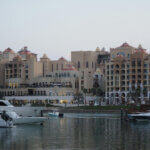
Wael M. Kabrit
Director of Operations
Danat Qatar L.L.C.
A brief overview of the Qatar real estate market in the runup-to FIFA World Cup ™ Qatar 2022
The FIFA Tournament Time Demand Model anticipates that over 1.5 million visitors will travel to Qatar for the FIFA World Cup ™, including at least 500,000 visitors on the busiest days. It has been reported that tourism will increase as a result, driving demand for accommodation and causing a large investment in the sector. Over 5,000 transactions valued at least QR25 billion were conducted in Qatar last year alone, an increase of 5 percent from the previous year, demonstrating the sector’s continuing importance in the country’s economy.
Qatar has already won international acclaim for its World Cup ™ preparations in part because of its commitment to innovation and sustainability. The Planning and Statistics Authority has reported that in the fourth quarter of 2021, the Qatari GDP expanded by 2 percent year over year, and this will only tick up further this year as well. The residential housing market is expected to be bolstered even further by the addition of more than 15,000 residential units this year, according to a survey released by ValuStrat, a real estate consulting company.
The 2022 World Cup ™ is set to change the landscape of Doha and beyond forever. While it would directly aid in the residential rental market’s recovery, a number of other factors also have an impact, including the government’s demonstrated grit in combating the pandemic, successful vaccine rollouts that have positioned Qatar as a secure and welcoming business destination, a strong domestic focus on job creation, and financial incentives.
1. Upward pressure on rental rates
Qatar’s real estate sector has been witnessing an upward trend in rental rates since 2015. Prices in most of the communities in prime locations are ticking up compared with a year back. The impact of increased demand on rental levels has been most evident in prime apartments, where rental rates for new leases have increased by 10 percent to 15 percent, especially as the supply of property remains tight.
With the start of the 2022 FIFA World Cup ™ now just months away, the fourth quarter is projected to follow suit. We may witness a scenario where demand continues to outstrip supply and put upward pressure on rents, reflecting an ongoing search for space ahead of the tournament. Established villa communities with lower occupancy, as well as premium and beachfront locations, are likely to enjoy greater rental resiliency.
2. Increase in long-term leases to lessen the impact of reduced demand in 2023.
Many residents say they’re seeing big swings as they prepare to renew their leases. What’s behind those increases? The landlords are highly motivated to plan for the long term and to write conservative leases that maximise the return on their assets. The pandemic was kind of a pause on the economy; however, things are ticking up now, business is picking up, and rents are going up.
Several landlords, coming from the back end of making losses as a result of the pandemic, will mostly prefer tenants who will commit to long-term leases. Multi-year leases provide greater stability and buffer from further hits in the event of declining rental rates post World Cup ™. This also provides landlords with protection against revenue loss in the likelihood that their property will remain unoccupied after the existing tenant vacates. It’s however important to note that, with the country about to open its doors to possibly hundreds of new investors, property developers need to be aware of the shifting expectations of potential investors and clients. Offering value for money for properties will be key to attracting business.
3. Foreign investment opportunities
The International Monetary Fund (IMF) estimates that since being awarded the platform to host the 2022 FIFA World Cup ™, in 2010, Qatar’s GDP has grown consistently, with an average growth rate of 4.5 percent during an 11-year period from 2010, up until 2020. Given the relationship between economic activity and the real estate industry, a positive outlook for the property market is expected to continue, and the government has done so much to guarantee.
The World Cup ™ is not only an important strategic event but also a vital growth driver for a healthy economy beyond 2022, as well as an essential component of Qatar’s National Vision 2030. At the event, there will be many opportunities for high-level business networking with possible investors who will be in attendance and exploring new investment opportunities.
The Qatar Investment Promotion Agency, IPA Qatar, has already highlighted the real estate sector as one of the areas which are expected to draw foreign direct investment post-world cup ™. This presents a perfect opportunity for Qatar to fortify its long-term urban development and economic diversification goals, as well as increase its attractiveness as an economic hub. On a global scale, Qatar would be promoted as an appealing investment location.
There is no other single sporting event that can draw as much worldwide attention to a location like this. Its enormous and long-lasting benefits for economic growth are already evident. Experts may still be divided on what exactly the future holds, however, the next 12 months will reveal the true impact of successfully staging the world’s most iconic sporting event by Qatar.
This article was published as part of the eighth edition of Property Finder Qatar’s Trends Report.
You can also search for:
serviced apartments in doha
ain khaled cheap apartments for rent





